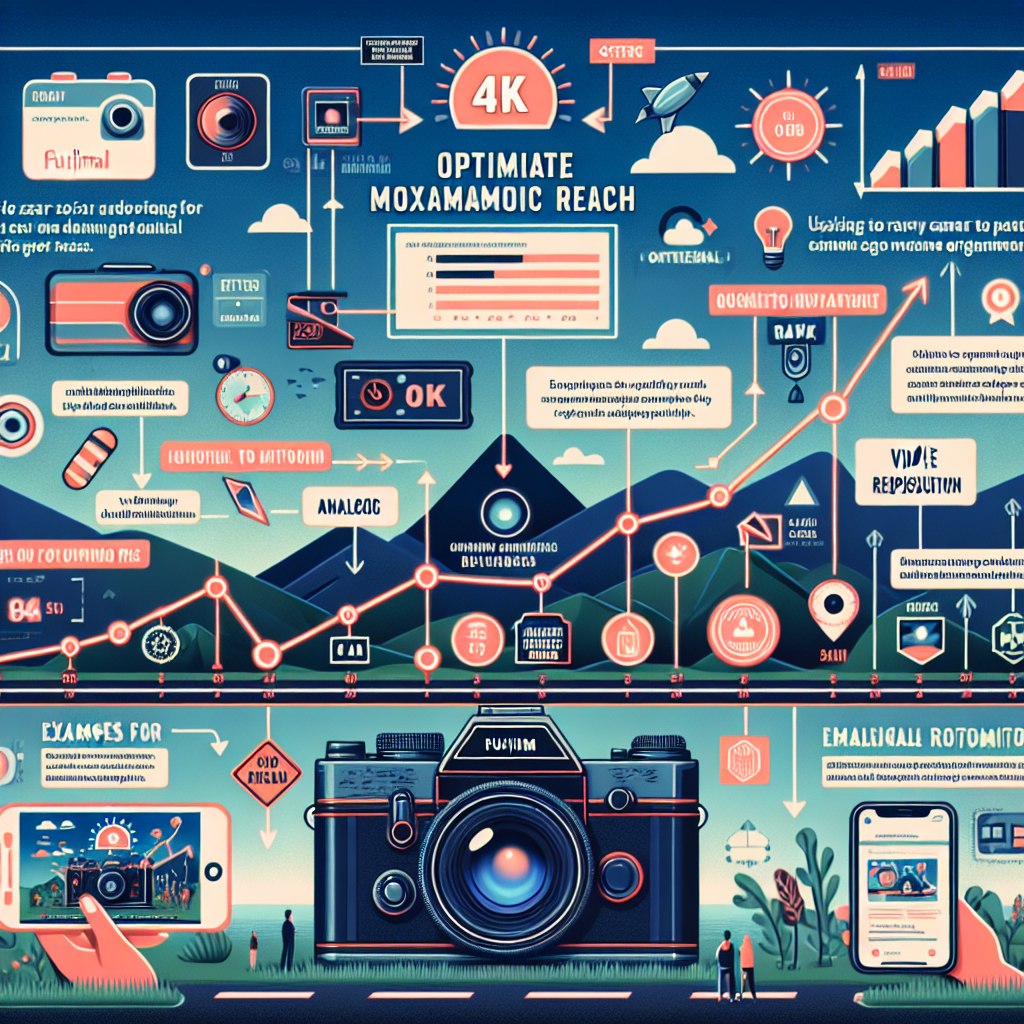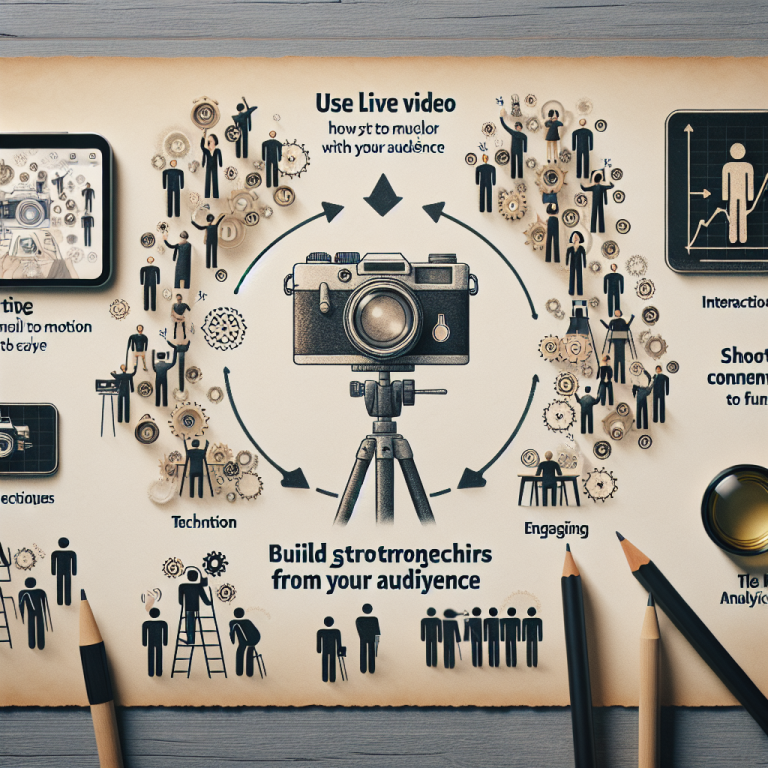How to Optimize Your Social Media Videos for Maximum Organic Reach
1. Understanding Your Target Audience
Research Your Demographics
Before diving into video creation, it’s crucial to know who you’re trying to reach. I’ve spent countless hours sifting through analytics to find patterns in viewer behavior. What I found was eye-opening: understanding demographics helps tailor content to meet your audience’s preferences, whether they’re teens on TikTok or professionals on LinkedIn.
Use platforms like Facebook Insights or Instagram Analytics to gather data on your viewers. Look for age groups, interests, and even location. This information paints a clearer picture of who’s watching. This step not only optimizes your content but also saves you from wasted efforts on the wrong audience.
Once you grasp who your audience is, you can create videos that resonate. For instance, if you’re targeting DIY enthusiasts, your videos should showcase quick, engaging tips. This helps in boosting organic reach as your videos will speak directly to those who are most likely to share them.
Create Engaging Content
Next up is content! The heart of any good video lies in its engagement. I always aim to tell a story, whether it’s through a tutorial, a behind-the-scenes peek, or even a fun challenge. Content that captivates will naturally encourage more shares and conversations.
Think about what excites your audience. Are they looking for entertainment, education, or inspiration? By aligning your content with their interests, you can create videos that compel viewers to engage, resulting in higher organic reach. I remember this one time I created a ‘how to’ video that spoke directly to current trends, and it blew up!
Also, don’t forget to include a call-to-action. Often, just prompting viewers to comment or share can drive engagement significantly. Ask questions or encourage them to tag friends. Engaging with your audience will increase your video’s visibility across platforms.
Leverage Visuals and Quality
The visual component of your video is paramount. From my experience, I can say that higher production values not only make your content look more professional but can also help in retaining viewers. So, invest in good lighting, clear audio, and a decent camera if possible—it pays off in the end.
Also, use attention-grabbing thumbnails. A good first impression can make or break a video. I often spend extra time creating an eye-catching thumbnail and it shows in the viewer stats; they click faster! Testing different styles to see what resonates can lead to significant improvements.
Lastly, always ensure that your videos are mobile-friendly since a large portion of viewers watch content on their devices. Your formatting and graphics should look great on a small screen. Trust me, no one wants to squint at a tiny video trying to figure out what’s happening!
2. SEO Optimization for Video Content
Choose the Right Keywords
Using SEO techniques for video is often overlooked, but it’s one of my secret weapons. Start by doing keyword research—think about what terms your target audience is searching for. Tools like Google Keyword Planner or Ubersuggest can be super helpful for this. I usually jot down a list of keywords that fit my video’s theme.
Once you have your keywords, sprinkle them throughout your video title, description, and tags. This tells algorithms what your video is about, which helps in showing it to the right audience. For example, if I was creating content on healthy recipes, I’d include terms like “easy healthy recipes” to attract viewers looking for that information.
Also, consider adding subtitles to your videos. Not only does this enhance accessibility, but it also incorporates keywords that can help your SEO. Plus, many people watch videos without sound—capturing their attention through text can retain those viewers better!
Craft Compelling Titles and Descriptions
The title and description of your video are essentially your first impressions. Make sure your title is catchy yet informative; it should give a clear sense of what viewers can expect. I’ve learned to strike a balance between being creative and being straightforward. A good rule is to keep it under 60 characters, allowing it to display fully on most platforms.
Your description should elaborate on the title. This is your chance to delve deeper into what the video covers. When I write descriptions, I always aim to include my keywords naturally but also provide enough information to entice viewers to click and watch!
Don’t shy away from adding links to your website, other videos of yours, or social media handles. This will help drive traffic across platforms and keep viewers engaged longer. The more pathways you provide, the better chance you have for organic reach!
Utilize Hashtags Effectively
Hashtags can be your best friend for reaching new audiences. They categorize your content and make it easier for users searching for specific topics to find your videos. I recommend conducting hashtag research to see what’s trending in your niche.
However, it’s essential to find a sweet spot—too many hashtags can look spammy, while too few might not make an impact. I generally stick with about 5-10 relevant hashtags that accurately convey the content of my videos. This practice ensures that I stay relevant while reaching out to new viewers.
Another tip I’ve found effective is to create a branded hashtag. When viewers start using it, it creates a sense of community around your content. This means more people might tag or share videos under that hashtag, leading to even more organic reach!
3. Promote Your Videos on Multiple Platforms
Cross-Promote Across Social Media
One of the major lessons I’ve learned over the years is not to limit my video’s exposure to just one platform. If I publish a video on Facebook, I always share snippets or teasers on Instagram, Twitter, and even LinkedIn. This multiplies the chances of someone discovering your content!
Each platform has its own audience, so tailor your teasers accordingly. For instance, on Instagram, I might share a short clip; whereas, on Facebook, I could share the full video and encourage discussion in the comments. Analyzing which platforms drive the most engagement helps me focus my efforts where it’s most effective.
Additionally, consider using platform-specific features to promote your videos. Instagram Stories or TikTok Duets can be vital for promoting your content in a not-so-obvious way. It keeps the promotion subtle but effective, ensuring viewers would want to check out the full video!
Engage with Your Community
It’s not just about posting; it’s about engagement! Take the time to respond to comments on your videos and interact with your community. When people feel valued, they’re more likely to share your content. I’ve seen a huge uptick in organic reach just from answering questions and engaging in discussions.
Hosting live Q&A sessions or giving viewers a behind-the-scenes look encourages deeper connections. When they see the person behind the videos, it humanizes you and makes them more likely to support and share your work.
Encouraging your viewers to share their thoughts helps not only in creating engagement but also in gathering feedback for future content. It’s a win-win situation where your community feels involved and you get insights to improve your videos!
Utilize Email Marketing
Email marketing can be a phenomenal way to boost your video reach. Introducing new videos to your subscribers can significantly bolster views right out of the gate. I personally enjoy crafting an engaging newsletter that highlights my latest content, offering viewers sneak peeks or special insights.
Make sure your emails are visually appealing and include clear links to your videos. I often use snippets or GIFs from the videos to capture attention instantly. It’s more likely to convert subscribers into viewers when they see a little taste of what’s to come!
Don’t forget to encourage people to subscribe to your list as well. Adding a simple signup form on your website or at the end of your videos goes a long way. Building an email list means that you own the connection and can reach your audience directly without relying too heavily on social media algorithms.
4. Analyze and Adjust Based on Metrics
Track Viewership and Engagement Stats
To optimize my videos for organic reach, I find it incredibly valuable to keep an eye on metrics. Platforms like YouTube and Instagram provide in-depth analytics about watch time, audience retention, and engagement rates. I dive into these stats regularly to see what’s clicking (or not clicking) with my audience.
Metrics not only tell you how many views you’re getting, but also allow you to see which parts of the video maintain attention or where viewers drop off. This feedback loop is crucial! I often take note of specific patterns and adjust future videos accordingly. For example, if analytics show that viewers drop off after the first minute, I may need to revamp my opening statements to grab attention quicker.
Engagement metrics, like comments and shares, matter too! They give you insight into how well your content resonates. If a particular video garners more interaction, it can provide clues about what to replicate in future projects.
Pivot Based on Feedback
Sometimes, I find that the comments or direct feedback from viewers are golden nuggets for growth. I always encourage constructive criticism and take it gracefully. If viewers express confusion or suggest new ideas, I take note—this feedback can spark fresh ideas that land better with my audience!
Creating videos is an evolving process, and adapting to what your community craves can set you apart. I’ve used viewer suggestions as jumping-off points for a whole new series before. It’s all about listening to your audience and focusing on what matters to them!
This practice of pivoting based on feedback not only increases organic reach but also fosters a strong community engagement. When your audience sees you taking their suggestions seriously, it builds loyalty and an encouraging space for them to become advocates for your content.
Experiment and Innovate
Don’t be afraid to experiment! I often test different styles, formats, or even video lengths to see what resonates best. Tracking the performance of these experiments is crucial in determining what works well and what might be a bit lackluster.
Think of experimenting as a way to keep your content fresh and innovative. I’ve tried everything from stop-motion videos to live recordings, and the variety not only keeps my audience engaged but adds an element of excitement for me as well!
Remember that not every experiment will succeed, and that’s perfectly okay. Each misstep is a learning opportunity, allowing me to adjust accordingly. Embracing a creative approach to content creation helps keep both me and my audience energized!
5. Stay Consistent with Your Posting Schedule
Establish a Regular Posting Routine
One thing I’ve found to be true in my years of creating social media content is that consistency is key. Establishing a regular posting schedule helps build anticipation among your audience. I make it a point to let my followers know when to expect new content, whether it’s weekly or biweekly.
When setting a routine, choose a frequency that’s sustainable. I recommend starting with a manageable goal—whether that’s one video a week or even one a month. This commitment helps keep your audience engaged as they’ll know when to check back for more!
Staying on schedule also boosts your algorithm performance on various platforms. Regular posting communicates to algorithms that you’re an active contributor, which can help your content get seen more often. Who doesn’t want that level of visibility?
Engage Your Audience with Series Content
Creating a series can be a fantastic way to keep your audience engaged. If viewers know that they can expect a thematic continuation, it creates more chances for them to return. For instance, I once did a weekly series on productivity tips and not only did my views spike, but my community grew substantially.
Series content encourages viewers to follow along, increasing the chances of regular engagement. You can even use cliffhangers or teasers to leave them wanting more, which can significantly boost organic reach!
Think about what you’re passionate about and how you can create content in series form. Maintaining a steady stream of content leads to building a loyal viewership over time—my favorite part of the journey!
Analyze Best Posting Times
Have you ever wondered when’s the best time to post? Well, so have I! It varies per platform and target audience, but analyzing when your viewers are most active can spread your reach tremendously. I’ve used tools like Hootsuite and Buffer to manage and analyze optimal posting times.
Sharing videos at peak times can increase engagement rates, leading to a cascading effect that improves overall visibility. When your audience is more likely to engage, this boosts your chances of reaching their friends and followers, extending your organic reach even further.
Track your performance over a few weeks to find patterns. Once you hit the sweet spot, sticking to those times plays a significant role in optimizing your content’s performance!
FAQs
1. How often should I post videos on social media?
Frequency can vary, but finding a schedule that works for you is essential. Start with a sustainable pace—whether weekly or biweekly. Consistency is key. Your audience should know when to expect new content!
2. What types of videos perform best on social media?
Engaging, relatable content tends to do well. Tutorials, behind-the-scenes looks, and trends often resonate with viewers. Following current trends while being authentic to your brand can help maximize performance.
3. How can I make my videos more engaging?
Tell a story, use humor, or present unique insights. Including interactive elements like polls or questions can significantly drive viewer engagement. Remember: the more interactive, the better!
4. Should I rely solely on social media algorithms for visibility?
No, while algorithms play a role, diversifying your approach helps. Promote your content across multiple platforms, use email marketing, and engage with the community. This multi-faceted approach can boost organic reach!
5. How important are metrics in video optimization?
Metrics provide valuable insights into what works and what doesn’t. Analyzing view counts, engagement rates, and audience retention helps in adjusting future content to better meet your audience’s preferences.








